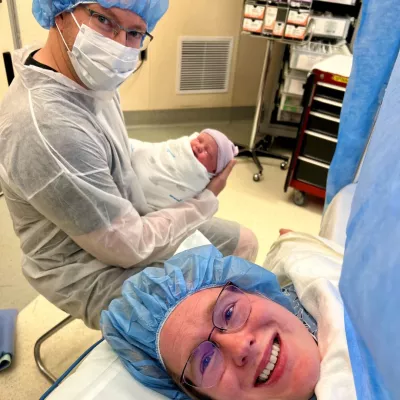- AdventHealth

A hysterectomy, which is the removal of the uterus and the cervix, is a serious surgery. Medical Group GYN Surgeon Dr. Angel Gonzalez-Rios says the most common reason for performing a hysterectomy is to treat serious, heavy bleeding and uterine leiomyomas, also known as fibroids.
Types of Hysterectomy Procedures
If an OBGYN suggests a hysterectomy as a viable treatment option for you, it’s important to know there are several different types of this procedure. Depending on the reason for the surgery, a total, partial or radical hysterectomy may be performed. There are also different approaches to consider.
In a total hysterectomy, both the uterus and cervix are removed. A partial hysterectomy leaves the cervix in place and removes only the upper part of the uterus. What’s known as a radical hysterectomy involves removing the entire uterus, cervix and other surrounding areas.
In addition to the type of hysterectomy, there are also varied methods for the actual performing of the surgery. Dr. Gonzalez-Rios shares that “Nowadays, most of our hysterectomy surgeries are performed in a minimally-invasive way, where, in most cases, patients are feeling about 80% to 90% better just two weeks after surgery.”
Minimally-invasive options, such as a laparoscopic approach, involve special instruments with much smaller incisions in the belly button, while a robotic approach would be similar but performed by a robotic platform that’s controlled by your surgeon. For more information on minimally-invasive procedures, click here.
Both robotic and laparoscopic surgeries are considered minimally-invasive and call for a shorter recovery time than the traditional method, which is performed vaginally, via open abdominal surgery. Only three to five percent of Dr. Gonzalez-Rios’ surgeries are done via open abdominal incisions.
Generally, Dr. Gonzalez-Rios says, the traditional method of surgery is only done in the event the patient has a large uterus or sometimes cancer. “A significantly larger uterus would not be safe to manage through the minimally invasive options,” he says. The recovery process with a traditional hysterectomy requires a longer hospital stay, longer recovery before returning to work and overall they experience more pain because of the type of incision.
Non-Surgical Options
Some patients can effectively be treated without surgery. “There are multiple reasons why a patient may be bleeding heavily or irregularly, so we always look at every patient individually to offer the best treatment option for them, which can be to start with medical management before a potential surgery,” says Dr. Gonzalez-Rios.
Dr. Gonzalez-Rios typically tries medical management first and holds surgery as a last option. The most common medical management approach that AdventHealth gynecologists use is dependent on hormone management. Physicians try to prescribe medication that will suppress the stimulation of the uterus and control bleeding. Patients who are of child-bearing age and see children in their future would try these types of medication first, as a hysterectomy would result in the inability to have children.
“Sometimes in our treatment plans, we try to do medical management for at least three months before looking into alternatives if the patient is trying to avoid surgery, because we know that’s how long it would take for a patient to get the full benefit of medication. These could be pills, injections or vaginal rings — whatever option best suits the patient’s needs,” says Dr. Gonzalez-Rios.
More Information
To learn more about gynecology offerings at AdventHealth for Women, including locations and physicians, click here.



